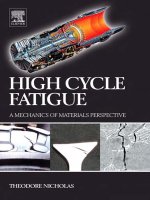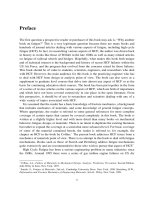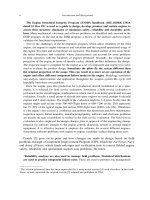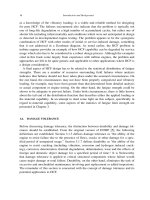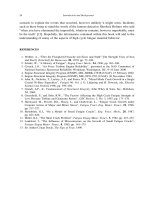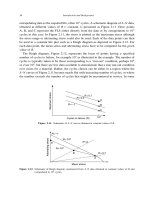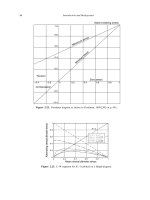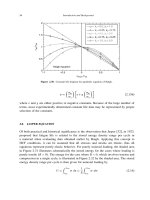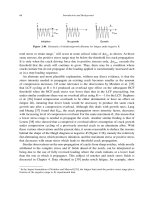Mechanics of Materials 1 Part 7 ppsx
Bạn đang xem bản rút gọn của tài liệu. Xem và tải ngay bản đầy đủ của tài liệu tại đây (3.75 MB, 70 trang )
$15.2
Theories
of
Elastic Failure
403
15.2. Maximum shear stress theory
This theory states that failure can be assumed to occur when the maximum shear stress in
the complex stress system becomes equal to that at the yield point in the simple tensile test.
Since the maximum shear stress is half the greatest difference between two principal
stresses the criterion of failure becomes
i.e.
(15.1)
the value of
a3
being algebraically the smallest value, i.e. taking account of sign
and
the fact
that one stress may
be
zero.
This produces fairly accurate correlation with experimental
results particularly for ductile materials, and is often used for ductile materials in machine
design. The criterion is often referred to as the “Tresca” theory and is one of the widely used
laws of plasticity.
15.3. Maximum principal strain theory
This theory assumes that failure occurs when the maximum strain in the complex stress
system equals that at the yield point in the tensile test,
i.e.
a1 a2
-va3
=
ap
This theory is contradicted by the results obtained from tests on flat plates subjected to two
mutually perpendicular tensions. The Poisson’s ratio effect of each tension reduces the strain
in the perpendicular direction
so
that according to this theory failure should occur at a higher
load. This is not always the case. The theory holds reasonably well for cast iron but is not
generally used in design procedures these days.
(15.2)
15.4.
Maximum total strain energy per unit volume theory
The theory assumes that failure occurs when the total strain energy in the complex stress
system is equal to that at the yield point in the tensile test.
From the work of
$14.17
the criterion of failure is thus
1
0:
-
[a:
+
a:
+
a:
-
2v(a,a,
+
a2a3
+
a3a1)]
=
-
2E 2E
i.e.
uf
+
af
+a:
-
2v(a1
a2
+
aza3
+
03~1)
=
a:
(15.3)
The theory gives fairly good results for ductile materials but is seldom used in preference to
the theory below.
15.5. Maximum shear strain energy per unit volume
(or distortion energy) theory
Section
14.17
again indicates how the strain energy of a stressed component can be divided
into volumetric strain energy and shear strain energy components, the former being
404
Mechanics
of
Materials
$15.6
associated with volume change and no distortion, the latter producing distortion of the
stressed elements. This theory states that failure occurs when the maximum shear strain
energy component in the complex stress system is equal to that at the yield point in the tensile
test,
i.e.
or
1
u2
-
6G
c0:
+
0:
+
0:
-
(ala2
+
0203
+
O3O1)
=
2
6G
(a1
-
a2)2
+
(a2
-
up)?
+
(a3
-
61
)2
=
24
(15.4)
This
theory has received considerable verification in practice and is widely regarded as the
most reliable basis for design, particularly when dealing with ductile materials. It is often
referred to as the “von Mises” or “Maxwell” criteria and is probably the best theory of the
five. It is also sometimes referred to as the
distortion energy
or
maximum
octahedral
shear
stress
theory.
In the above theories it has been assumed that the properties of the material in tension and
compression are similar. It is well known, however, that certain materials, notably concrete,
cast iron, soils, etc., exhibit vastly different properties depending on the nature of the applied
stress. For brittle materials this has been explained by Griffith,? who has introduced the
principle of surface energy at microscopic cracks and shown that an existing crack will
propagate rapidly
if
the available elastic strain energy release is greater than the surface
energy of the crack.$ In this way Griffith indicates the greater seriousness of tensile stresses
compared with compressive ones with respect to failure, particularly in fatigue environments.
A
further theory has been introduced by Mohr to predict failure of materials whose strengths
are considerably different in tension and shear; this is introduced below.
15.6.
Mohr’s modified shear stress theory for brittle materials
(sometimes referred to as the internal friction theory)
Brittle materials in general show little ability to deform plastically and hence will usually
fracture at, or very near to, the elastic limit. Any of the so-called “yield criteria” introduced
above, therefore, will normally imply fracture of a brittle material. It has been stated
previously, however, that brittle materials are usually considerably stronger in compression
than in tension and to allow for this Mohr has proposed a construction
based
on his stress
circle in the application of the maximum shear stress theory. In Fig. 15.1 the circle on
diameter
OA
is that for pure tension, the circle on diameter
OB
that for pure compression and
the circle centre
0
and diameter
CD
is that for pure shear. Each of these types of test can be
performed to failure relatively easily in the laboratory. An envelope to these curves, shown
dotted, then represents the failure envelope according to the Mohr theory.
A
failure condition
is then indicated when the stress circle for a particular complex stress condition is found to cut
the envelope.
t
A.
A.
Griffith, The phenomena
of
rupture and flow
of
solids,
Phil.
Trans. Royal SOC.,
London,
1920.
$
J.
F.
Knott,
Fundamentals
of
Fracture Mechanics
(Butterworths, London),
1973.
$15.6
Theories
of
Elastic Failure
405
Y
I
Fig.
15.1.
Mohr
theory on
0-T
axes.
As
a close approximation to this procedure Mohr suggests that only the pure tension and
pure compression failure circles need
be
drawn with
OA
and
OB
equal to the yield or fracture
strengths of the brittle material. Common tangents to these circles may then
be
used as the
failure envelope as shown in Fig.
15.2.
Circles drawn tangent to this envelope then represent
the condition of failure
at
the point of tangency.
r
Fig.
15.2.
Simplified
Mohr
theory
on
g-7
axes.
In order to develop a theoretical expression for the failure criterion, consider a general
stress circle with principal stresses of
o1
and
02.
It is then possible to develop an expression
relating
ol,
02,
the principal stresses, and
o,,, o,,,
the yield strengths of the brittle material in
tension and compression respectively.
From the geometry of Fig.
15.3,
KL JL
KM MH
-=-
Now, in terms of the stresses,
KL
=$(.I
+o,)-oa,
+$c~,=$(D~,-Q~
+a,)
K
M
=
$a,,
+
*oyc
=
f
(oY,
+
on)
JL
=
$(01+
02)
-$o,,
=
$(GI
+
62
-
oy,)
MH='~
-Lo
-o
)
2
Yc
2
Y,
2
Yc
Y,
406
Mechanics
of
Materials
$15.7
T
t
Fig.
15.3.
Substituting,
ayI-ao,+a2 al+a2-ayl
- -
CY1
+
OYc
CY,
-
QYI
Cross-multiplying and simplifying this reduces to
(15.5)
01
02
-+-=
1
by,
CY,
which is then the Mohr's modified shear stress criterion for brittle materials.
15.7.
Graphical representation
of
failure theories
for
two-dimensional
stress systems (one principal stress zero)
Having obtained the equations for the elastic failure criteria above in the general three-
dimensional stress state it is relatively simple to obtain the corresponding equations when
one of the principal stresses is zero.
Each theory may be represented graphically as described below, the diagrams often being
termed
yield loci.
(a)
Maximum principal
stress
theory
For simplicity of treatment, ignore for the moment the normal convention for the principal
stresses, i.e.
a1
>
a2
>
a3
and consider the two-dimensional stress state shown in
Fig.
15.4
i-'
Fig.
15.4.
Two-dimensional stress state
(as
=
0).
$15.7
Theories
of
Elastic Failure
407
where
a3
is zero and
a2
may
be
tensile or compressive as appropriate, i.e.
a2
may have a value
less than
a3
for the purpose of this development.
The maximum principal stress theory then states that failure will occur when
a1
or
a2
=
a,,,
or
a,,,.
Assuming
a,,,
=
a,,,
=
a,,,
these conditions are represented graphically on
aI, a2
coordinates as shown in Fig. 15.5. If the point with coordinates
(al, a2)
representing any
complex two-dimensional stress system falls outside the square, then failure will occur
according to the theory.
02
t
Fig.
15.5.
Maximum principal stress failure envelope
(locus).
(b)
Maximum shear stress theory
For
like stresses,
i.e.
a1
and
a2,
both tensile or both compressive (first and third quadrants),
the maximum shear stress criterion is
+(al
-0)
=
$0,
or
$(a2
-0)
=+ay
i.e.
a1
=
ay
or
a2
=ay
thus producing the same result as the previous theory in the first and third quadrants.
For
unlike stresses
the criterion becomes
+(a1
-
62)
=
3.y
since consideration of the third stress as zero will not produce as large a shear as that when
a2
is negative. Thus for the second and fourth quadrants,
These are straight lines and produce the failure envelope of Fig.
15.6.
Again, any point outside
the failure envelope represents a condition of potential failure.
(c)
Maximum principal strain theory
For yielding in tension the theory states that
61
a2
=
by
408
Mechanics
of
Materials
515.7
Fig.
15.6.
Maximum
shear
stress failure envelope
and for compressive yield, with
o2
compressive,
Since this theory does not find general acceptance in any engineering field it is sufficient to
note here, without proof, that the above equations produce the rhomboid failure envelope
shown in Fig. 15.7.
4
Fig.
15.7.
Maximum principal strain failure envelope.
(d)
Maximum strain
energy per
unit
oolume
theory
With
c3
=
0
this failure criterion reduces
to
a:+a;-2vo,02
=
6;
i.e.
01
5.7
Theories
of
Elastic Failure
409
This is the equation of an ellipse with major and minor semi-axes
*Y
*'
and
J(1
-
4
J(1
+
4
respectively, each at
45"
to
the coordinate axes as shown in Fig.
15.8.
Fig. 15.8. Failure envelope
for
maximum strain energy per unit volume theory.
(e)
Maximum shear strain energy per unit
volume
theory
With
o3
=
0
the criteria of failure for this theory reduces to
$[
(01
-
a2)2
+
*:
+
41
=
0;
a:+a;-rJa,a2
=
0;
py+(;y-(:)(;)=
1
again an ellipse with semi-axes
J(2)ay
and
,/(*)cy
at
45"
to the coordinate axes
as
shown in
Fig.
15.9.
The ellipse will circumscribe the maximum shear stress hexagon.
\Sheor
diagonal
I
Fig.
15.9.
Failure envelope
for
maximum shear strain energy per unit volume theory.
410
Mechanics
of
Materials
515.8
(f)
Mohr’s modijied shear stress theory
(cJ,,,
>
cy,)
For the original formulation of the theory based on the results of pure tension, pure
compression and pure shear tests the Mohr failure envelope is as indicated in Fig.
15.10.
In its simplified form, however, based on just the pure tension and pure compression
results, the failure envelope becomes that
of
Fig.
15.11.
Fig.
15.10.
(a) Mohr theory
on
u-T
axes.
(b)
Mohr theory failure envelope
on
u,-u2
axes.
Q2
Fig.
15.1
1.
(a)
Simplified Mohr theory on
u-T
axes.
(b)
Failure envelope for simplified Mohr theory.
15.8.
Graphical solation of two-dimensional theory
of
failure problems
The graphical representations of the failure theories, or yield loci, may
be
combined onto a
single set of
ol
and
o2
coordinate axes
as
shown in Fig.
15.12.
Inside any particular locus or
failure envelope elastic conditions prevail whilst points outside the loci suggest that yielding
or fracture will occur. It will be noted that in most cases the maximum shear stress criterion is
the most conservative
of
the theories. The combined diagram is particularly useful since it
allows experimental points
to
be
plotted to give an immediate assessment of failure
515.9
Theories
of
Elastic Failure
41
1
Fig.
15.12.
Combined
yield
loci for the various failure theories.
probability according to the various theories. In the case of equal biaxial tension or
compression for example
al/uz
=
1
and
a
so-called
load line
may be drawn through the
origin with a slope
of
unity to represent this loading case. This line cuts the yield loci in the
order of theories
d;
(a,
b,
e,
f
);
and
c.
In the case
of
pure torsion, however,
u1
=
z
and
uz
=
-
z,
i.e.
al/az
=
-
1.
This load line will therefore have a slope of
-
1
and the order of yield
according to the various theories is now changed considerably to
(b;
e,
f,
d,
c,
a).
The load line
procedure may
be
used to produce rapid solutions of failure problems as shown in
Example
15.2.
15.9.
Graphical representation of the failure theories for
threedimensional stress systems
15.9.1.
Ductile materials
(a)
Maximum shear strain energy or distortion energy (uon Mises) theory
It has been stated earlier that the failure of most ductile materials is most accurately
governed by the distortion energy criterion which states that, at failure,
(al
-
az)’
+
(az
-
a3)’
+
(a3
-
al)’
=
2a,Z
=
constant
In the special case where
u3
=
0,
this has been shown to give a yield locus which is an ellipse
symmetrical about the shear diagonal. For a three-dimensional stress system the above
equation defines the surface of a regular prism having a circular cross-section, i.e.
a
cylinder
with its central axis along the line
u1
=
uz
=
u3.
The axis thus passes through the origin of the
principal stress coordinate system shown in Fig.
15.13
and is inclined at equal angles to each
412 Mechanics of Materials
§15.9
Fig. 15.13. Three-dimensional yield locus for Maxwell-von Mises distortion energy (shear strain
energy per unit volume) theory.
axis. It will be observed that when 0'3 = O the failure condition reverts to the ellipse
mentioned above, i.e. that produced by intersection of the (0'1'0'2) plane with the inclined
cylinder.
The yield locus for the von Mises theory in a three-dimensional stress system is thus the
surface of the inclined cylinder. Points within the cylinder represent safe conditions, points
outside indicate failure conditions. It should be noted that the cylinder axis extends
indefinitely along the 0' 1 = 0' 2 = 0' 3line, this being termed the hydrostatic stress line. It can be
shown that hydrostatic stress alone cannot cause yielding and it is presumed that all other
stress conditions which fall within the cylindrical boundary may be considered equally safe.
(b) Maximum shear stress (Tresca) theory
With a few exceptions, e.g. aluminium alloys and certain steels, the yielding of most ductile
materials is adequately governed by the Tresca maximum shear stress condition, and because
ofits relative simplicity it is often used in preference to the von Mises theory. For the Tresca
theory the three-dimensional yield locus can be shown to be a regular prism with hexagonal
cross-section (Fig. 15.14). The central axis of this figure is again on the line 0"1 = 0"2 = 0"3 (the
hydrostatic stress line) and again extends to infinity.
Points representing stress conditions plotted on the principal stress coordinate axes
indicate safe conditions if they lie within the surface of the hexagonal cylinder. The two-
dimensional yield locus of Fig. 15.6 is obtained as before by the intersection of the 0"1' 0"2
plane (0"3 = 0) with this surface.
15.9.2. Brittle materials
Failure of brittle materials has been shown previously to be governed by the maximum
principal tensile stress present in the three-dimensional stress system. This is thought to be
815.10
Theories
of
Elastic Failure
g3
Hydrost
otic
line
u,
=
u =u3
413
stress
Two-dimensional yield
IJCUS
I
/,:
LJ
locus
(hexagonal cylinder)
Fig. 15.14. Three-dimensional yield locus for Tresca (maximum shear stress) theory.
due to the microscopic cracks, flaws or discontinuities which are present in most brittle
materials and which act as local stress raisers. These stress raisers, or
stress concentrations,
have a much greater adverse effect in tension and hence produce the characteristic weaker
behaviour of brittle materials in tension than in compression.
Thus if the greatest tensile principal stress exceeds the yield stress then failure occurs, and
such a simple condition does not require a graphical representation.
15.10.
Limitations of the failure theories
It
is important to remember that the theories introduced above are those of
elastic
failure,
i.e. they relate to the “failure” which is assumed to occur under elastic loading conditions at an
equivalent stage to that of yielding in a simple tensile test. If it is anticipated that loading
conditions are such that the component may fail in service in a way which cannot easily be
related to standard simple loading tests (e.g. under fatigue, creep, buckling, impact loading,
etc.) then the above “classical” elastic failure theories should not be applied.
A
good example
of this is the brittle fracture failure of steel under low temperature or very high strain rate
(impact) conditions compared with simple ductile failure under normal ambient conditions.
If
any doubt exists about the relevance of the failure theories then, ideally, specially designed
tests should
be
carried out on the component with loading conditions as near as possible to
those expected in service. If, however, elastic failure can
be
assumed to
be
relevant it is
necessary to consider which of the theories is the most appropriate for the material in
question and for the service loading condition expected.
In most cases the Von Mises “distortion energy” theory is considered to be the most
reliable and relevant theory with the following exceptions:
(a) For brittle materials the maximum principal stress or Mohr “internal friction” theories
are most suitable. (It must be noted, however, that the former is definitely unsafe for
ductile materials.) Some authorities also recommend the Mohr theory for extension of
414 Mechanics
of
Materials $15.11
the theories to ductilefracture consideration as opposed to ductile yielding as assumed in
the elastic theories.
(b) All theories produce similar results in loading situations where one principal stress is
large compared to another. This can
be
readily appreciated from the graphical
representations if a load-line is drawn with
a
very small positive or negative slope.
(c) The greatest discrepancy between the theories is found in the second and fourth
quadrants of the graphical representations where the principal stresses are of opposite
sign but numerically equal.
(d) For bi-axial stress conditions, the Mohr modified theory is often preferred, provided that
reliable test data are available for tension, compression and torsion.
(e) In most general bi-axial and tri-axial stress conditions the Tresca maximum shear stress
theory is the most conservative (i.e. the safest) theory and this, together with its easily
applied and simple formula, probably explains its widespread use in industry.
(f)
The St. Venant maximum principal strain and Haigh total strain energy per unit volume
theories are now rarely, if ever, used in general engineering practice.
15.11.
Effect of stress concentrations
Whilst stress concentrations have their most significant effect under fatigue loading
conditions and impact situations, nevertheless, there are also some important considerations
for static loading applications, namely:
(a) In the presence of ductile yielding, stress concentrations are relatively unimportant since
the yielding which will occur at the concentration, e.g. the tip of a notch, will merely
redistribute the stresses and not necessarily lead to failure.
If,
however, there is only
marginal ductility, or in the presence of low temperatures, then stress concentrations
become more significant as the likelihood of brittle failure increases. It is wise, therefore,
to keep stress concentration factors
as
low
as
possible.
(b) For brittle materials like cast iron, internal stress concentrations arise within the material
due to the presence of, e.g., flaws, impurities or graphite flakes. These produce stress
increases at least as large as those given by surface stress concentrations which, therefore,
may have little or no effect on failure.
A
cast iron
bar
with
a
small transverse hole, for
example, may not fracture at the hole when a tensile load is applied!
15.12.
Safety factors
When using elastic design procedures incorporating any of the failure theories introduced
in this chapter it is normal to incorporate safety factors to take account
of
various
imponderables which arise when one attempts to forecast accurately service loads or
operating conditions or to make allowance for variations in material properties or behaviour
from those assumed
by
the acceptance
of
“standard values. “Ideal” application of the
theories, i.e.
a
rigorous mathematical analysis, is thus rarely possible and the following factors
indicate in a little more detail the likely sources of inaccuracy:
1.
Whilst design may have been
based
up nominally static loading, changing service
conditions or misuse by operators can often lead to dynamic, fluctuating
or
impact
loading situations which will produce significant increases in maximum stress levels.
$15.12
Theories
of
Elastic Failure
41
5
2.
A
precise knowledge of the mechanical properties of the material
used
in the design is
seldom available. Standard elastic values found in reference texts assume ideal homoge-
neous and isotropic materials with equal “strengths” in all directions.
This
is rarely true in
practice and the effect of internal flaws, inclusions or other weaknesses in the material may
be quite significant.
3.
The method of manufacture or construction of the component can have a significant effect
on service life, particularly if residual stresses are introduced by, e.g., welding or straining
beyond the elastic limit during the assembly stages.
4.
Complex designs often give rise to difficult analysis problems which even after time-
consuming and expensive theoretical procedures, at best yield only a reasonable estimate
of maximum service stresses.
Despite these problems and the assumptions which are often required to overcome them, it
has been shown that elastic design procedures can be made to agree with experimental results
within a reasonable margin of error provided that appropriate safety factors are applied.
It has been shown in
$1.16
that alternative definitions are used for the safety factor
depending upon whether it is based on the tensile strength of the material used or its yield
strength, i.e., either
tensile strength
allowable working stress
safety factor,
n
=
Application
Steelwork in buildings
Pressure vessels
Transmission shafts
Connecting rods
or
(a)
(b)
(4
Overall
Nature of
Nature of
Type, of safety factor
1 1
2 2
1
1 3
3
3
1
2
6
3 2
1.5
9
stress load
SerVlCe
(4
x
(b)
x
(4
yield stress (or proof stress)
allowable working stress
safety factor,
n
=
Clearly,
it is important when quoting safety factors to state which definition has been used.
Safety values vary depending on the type of industry and the area of application of the
component being designed. National codes of practice (e.g. British Standards) or other
external authority regulations often quote mandatory values to be applied and some
companies produce their own guideline values.
Table
15.2
shows the way in which the various factors outlined above contribute to the
overall factor of safety for some typical service conditions. These values are based on the yield
stress of the materials concerned.
TABLE
15.2.
Typical safety factors.
It should be noted, however, that the values given in the “type of service” column can be
considered to be conservative and severe misuse or overload could increase these (and, hence,
the overall factors) by as much as five times.
Recent legislative changes such as “Product Liability” and “Health and Safety at Work”
will undoubtedly cause renewed concern that appropriate safety factors are applied, and may
416
Mechanics
of
Materials
415.13
lead to the adoption of higher values. Since this could well result in uneconomic utilisation of
materials, such a trend would be regrettable and a move to enhanced product testing and
service load monitoring
is
to be preferred.
15.13.
Modes
of
failure
Before concluding this chapter, the first which looks at design procedures to overcome
possible failure (in this case elastic overload), it is appropriate to introduce the reader to the
many other ways in which components may fail in order that an appreciation is gained of the
complexities often facing designers of engineering components. Subclassification and a
certain amount of cross-referencing does make the list appear to be formidably long but even
allowing for these it is evident that the designer, together with his supporting materials and
stress advisory teams, has an unenviable task if satisfactory performance and reliability of
components is to be obtained in the most complex loading situations. The list below is thus a
summary of the so-called
“modes (or methods)
offailure”
1.
Mechanical overload/under-design
2.
Elastic yielding
-
force and/or temperature induced.
3.
Fatigue
high cycle
low cycle
thermal
corrosion
fretting
impact
surface
4.
Brittle fracture
5.
Creep
6.
Combined creep and fatigue
7.
Ductile rupture
8.
Corrosion
direct chemical
galvanic
pitting
cavitation
stress
intergranular
crevice
erosion
hydrogen damage
selective leaching
biological
corrosion fatigue
fracture
fatigue
9.
Impact
$15.13
Theories
of
Elastic Failure
417
deformation
wear
fretting
10. Instability
buckling
creep buckling
torsional instability
adhesive
abrasive
corrosive
impact
deformation
surface fatigue
fretting
12. Vibration
13. Environmental
11. Wear
thermal shock
radiation damage
lubrication failure
spalling
pitting
galling and seizure
15. Stress rupture
16. Thermal relaxation
14. Contact
Examples
Example
15.1
A
material subjected to a simple tension test shows an elastic limit of
240
MN/m2.
Calculate the factor of safety provided if the principal stresses set up in a complex two-
dimensional stress system are limited to 140 MN/mZ tensile and 45 MN/m2 compressive. The
appropriate theories
of
failure on which your answer should
be
based are:
(a) the maximum shear stress theory;
(b) the maximum shear strain energy theory.
Solution
(a) Maximum shear stress theory
This theory states that failure will occur when the maximum shear stress in the material
equals the maximum shear stress value at the yield point in a simple tension test, i.e. when
or
418
Mechanics
of
Materials
In this case the system is two-dimensional, i.e. the principal stress in one plane is zero.
However, since one of the given principal stresses is a compressive one, it follows that the zero
value is that of
a2
since the negative value
of
a3
associated with the compressive stress will
produce a numerically greater value of stress difference
a,
-
u3
and hence must be used in the
above criterion.
Thus
a,
=
140
MN/m2,
u2
=
0
and
a3
=
-
45
MN/m2.
Now with a factor
of
safety applied the design yield point becomes
o,/n
and this must
replace
cy
in the yield criterion which then becomes
240
n
-
=
140- (-45)
units of MN/m2 throughout
240
185
n
=
-
=
1.3
The required factor of safety is
1.3.
(b)
Maximum shear strain energy theory
Once again equating the values of the quantity concerned in the tensile test and in the
complex stress system,
a;
=
5
[(a,
-
a2)2
+
(a2
-
a3)2
+
(a3
-
01)23
With the three principal stress values used above and with o,/n replacing
ay
(
F)2
=
+{
(140-0)2
+
[0-
(
-45)12
+
(-45
-
140)2}
5.76
x
104
=
f
C1.96
+
0.203
+
3.421
lo4
n2
2
x
5.76
x
104
n2
= =
2.063
5.583
x
lo4
n
=
1.44
The required factor of safety is now
1.44.
Example
15.2
A
steel tube has a mean diameter of 100mm and a thickness of
3
mm. Calculate the torque
which can be transmitted by the tube with a factor of safety of
2.25
if the criterion of failure is
(a)
maximum shear stress; (b) maximum strain energy;
(c)
maximum shear strain energy. The
elastic limit
of
the steel in tension is
225
MN/m2 and Poisson’s ratio
v
is
0.3.
Theories
of
Elastic Failure
419
Solution
From the torsion theory
T.r. TR
J=R
“
‘=y
-
Now mean diameter of tube
=
100
mm and thickness
=
3
mm.
nd3t
J
=
ndt
x
r’
=
-
(approximately)
4
x
0.13
x
0.003
- -
=
2.36
x
10-6m4
4
T
x
51.5
x
10-3
shear stress
T
=
=
(2.18
x
104)T
N/m’
2.36
x
=
21.8T
kN/m’
(a) Maximum shear stress
Torsion introduces pure shear onto elements within the tube material and it has been
shown in
Q
13.2
that pure shear produces an equivalent principal direct stress system, one
tensile and one compressive and both equal in value to the applied shear stress,
i.e.
o1
=
7,
o3
=
-7
(and
o2
=
0)
Thus for the maximum shear stress criterion, taking account of the safety factor,
-
OY
=01-03=7-(-7)
n
=
27
=
2
x
21.8~
x
103
225
x
lo6
2.25
100
x
106
T=
=
2.3x
103~m
2
x
21.8
x
103
The torque which can be safely applied
=
2.3
kN m.
(b)
Maximum strain energy
From eqn.
(15.3)
the relevant criterion of failure is
CT:
=
0:
+
C:
+
0:
-
2~(0102
+
0203
+
0301)
Taking account of the safety factor
(22:;;“)’
=
7’
+o
+
(-
7)’
-
2
x
0.3~~
x
(-41
=
2.6~~
=
2.6(21.8
x
103T)’
420
Mechanics
of
Materials
loo
x
106
J(2.6)
x
21.8
x
lo3
T=
=
2.84
x
103
N
rn
The safe torque is now 2.84 kN m.
(c) Maximum shear strain energy
From eqn. (15.4) the criterion of failure is
6;
=
3
[(ol
-
az)z
+
(a2
-
+
(63
-
61)Zl
=
2.65
x
103
N
rn
100
x
lo6
T=zxzKp
The safe torque is now 2.65 kNm.
Example
15.3
A
structure is composed of circular members of diameter
d.
At a certain position along one
member the loading is found to consist of
a
shear force of 10 kN together with an axial tensile
load of 20 kN.
If
the elastic limit in tension of the material of the members is 270 MN/mZ and
there is to be a factor of safety of
4,
estimate the magnitude of
d
required according to (a) the
maximum principal stress theory, and (b) the maximum shear strain energy per unit volume
theory. Poisson’s ratio
v
=
0.283.
Solution
The stress system at the point concerned is as shown in Fig. 15.15, the principal stress
Now the direct stress along the axis of the bar is tensile, i.e. positive, and given by
normal to the surface of the member being zero.
=-=-
6,
=
-
load
2o
8o kN/mZ
area
xd2/4
ndz
Fig.
15.15.
Theories
of
Elastic Failure
42
1
and the shear stress is
=
40
kN/m2
shear load
10
nd2/4-
lrdZ
t=
area
The principal stresses are given by Mohr’s circle construction
(nd2
being
a
common
denominator) or from
a1
and
a3
=
3
(a,
+
oy)
f
3
&J,
-
+
4t,Zy]
with
ay
zero,
i.e.
40
nd2
=-(lfJ2)
40
x 2.414 30.7
kN,m2
=-
dZ
61
=
nd2
5.27
d2
=
-~
kN/m2
40
x 0.414
nd2
a3
=
-
and
02
=
0
Since the elastic limit in tension is
270
MN/mZ and the factor
of
safety is
4,
the working stress
or effective yield stress is
a,,
=
-
=
67.5
MN/m2
270
4
(a)
Maximum principal stress theory
Failure is assumed to occur when
61
=
ay
30.7 x
103
=
67.5
x
lo6
d2
d
=
2.13
x
m
=
21.3mm
(b)
Maximum shear strain energy
From eqn.
(15.4)
the criterion of failure is
20;
=
(a1
-
a2)2
+
(a2
-
O3)Z
+
(a3
-
a1)2
Therefore taking account of the safety factor
-
2264 x 106
-
d4
422
Mechanics
of
Materials
1132
x
lo6
(67.5
x
106)2
d4
=
33.6
x
103
d2
=
=
4.985
x
10-4m2
67.5
x
lo6
d
=
22.3mm
Example
15.4
Assuming the formulae for the principal stresses and the maximum shear stress induced in
a material owing to combined stresses and the fundamental formulae for pure bending,
derive a formula in terms of the bending moment
M
and the twisting moment
T
for the
equivalent twisting moment on a shaft subjected to combined bending and torsion for
(a)
the maximum principal stress criterion;
(b) the maximum shear stress criterion.
Solution
The
equivalent torque,
or turning moment, is defined as that torque which, actingalone, will
At failure the stress produced
by
the equivalent torque
TE
is given by the torsion theory
produce the same conditions
of
stress as the combined bending and turning moments.
Tz
JR
-
_-
-
TER TEx
D
=-
25
zmax=
-
J
The direct stress owing to bending is
4
Myma,- MD MD
a,=
=-
I
21
J
and the shear stress due to torsion is
TD
23
z=-
The principal stresses are then given by
al,
=
3
(a,
+
a,)
k
3
,/[(a,
-
a,)'
+
4zr,]
with
Q,
=
0
and
a2
=
0
D
25
=-((M_+J[MZ+T2])
Theories
of
Elastic Failure
423
D
25
D
25
o1
=-(M+J[MZ+Tz])
a3
=-(M-J[MZ+T2])
(a)
For
maximum principal stress criterion
D
25
25
TED
-
01
=
-
(M
+
J[MZ
+Tq)
T~
=
M
+
J(M~
+T~)
(b)
For
maximum shear stress criterion
D
25
-
(M
+
J[MZ
+TZ])
-
-
(M
-
J[MZ
+TZ])
Example
15.5
The test strengths of a material under pure compression and pure tension are
UY,
- -
350
MN/mZ and
cy,
=
300
MN/mZ. In a certain design of component the material may
be
subjected to each of the five biaxial stress states shown in Fig.
15.16.
Assuming that failure
is deemed to occur when yielding takes place, arrange the five stress states in order of
diminishing factor of safety according to the maximum principal or normal stress, maximum
shear stress, maximum shear strain energy (or distortion energy) and modified Mohr’s (or
internal friction) theories.
Solution
A
graphical solution of this problem can
be
employed by constructing the combined yield
loci for the criteria mentioned in the question. Since
u1
the maximum principal stress is
+
100
MN/mZ in each of the stress states only half the combined loci diagram is required, i.e.
the positive
u1
half.
Here it must
be
remembered that for stress conditio8 (e) pure shear is exactly equivalent to
two mutually perpendicular direct stresses
-
one tensile, the other compressive, acting on
45”
planes and of equal value to the applied shear, i.e. for condition (e)
a1
=
100
MN/m2 and
az
=
-
100
MN/m2
(see
$13.2).
It is now possible to construct the “load lines” for each stress state with slopes of
az/al.
An
immediate solution is then obtained by considering the intersection of each load line with the
failure envelopes.
424
Mechanics
of
Materials
Max.
Load line
(c)
Max shear strain energy
(distortion energy theory)
Max. principal stress
shear stress
Fig.
15.16.
Maximum principal stress theory
All five load lines cut the failure envelope for this theory at
o1
=
300 MN/mZ. According to
this theory, therefore, all the stress states will produce failure when the maximum direct stress
reaches 300MN/m2. Since the maximum principal stress present in each stress state is
100MN/mZ it therefore follows that the safety factor for each state according to the
maximum principal stress theory is
-
=
3.
300
100
Maximum shear stress theory
The load lines
a,
band
c
cut the failure envelope for this theory at
o1
=
300 MN/m2 whilst
d
and
e
cut it at
o1
=
200 MN/m2 and
o1
=
150 MN/m2 respectively as shown in Fig. 15.16.
The safety factors are, therefore,
300 200 150
100
a,b,c= =3,
d=-=2
e= =15
100
'
100
*
Maximum shear strain energy theory
In decreasing order, the factors of safety for this theory, found
as
before from the points
where each load line crosses the failure envelope, are
Theories
of
Elastic Failure
425
Mohr’s modified or internal friction theory (with
cy,
=
350
MN/mZ)
In this case the safety factors are:
Example
15.6
The cast iron used in the manufacture of an engineering component has tensile and
(a) If the maximum value of the tensile principal stress is to
be limited to one-quarter of the
tensile strength, determine the maximum value and nature of the other principal stress
using Mohr’s modified yield theory for brittle materials.
(b) What would
be
the values
of
the principal stresses associated with a maximum shear
stress of
450
MN/mZ according to Mohr’s modified theory?
(c) At some point in a component principal stresses of 100MN/mZ tensile and
100MN/mZ compressive are found to
be
present. Estimate the safety factor with
respect to initial yield using the maximum principal stress, maximum shear stress,
distortion energy and Mohr’s modified theories of elastic failure.
compressive strengths of
400
MN/m2 and 1.20 GN/mZ respectively.
k2=-7WMN/mZ
~l!iCl
MN/m2
Fig.
15.17.
Solution
400
4
(a)
Maximum principal stress
=
-
=
100MN/mZ
According to Mohr’s theory
426
Mechanics
of
Materials
100
x
lo6
02
400
x
io6
+
-
1.2
x
109
.,
o2
=
-
1.2
x
109(1
-
a)
=
-900MN/m2
(b)
In any Mohr circle construction the radius of the circle equals the maximum shear
stress value. In order to answer this part of the question, therefore, it is necessary to
draw the Mohr failure envelope on
o-r
axes as shown in Fig.
15.17
and to construct the
circle which is tangential to the envelope and has a radius of 450MN/m2. This is
achieved
by
drawing a line parallel to the failure envelope and a distance
of
450
MN/m2 (to scale) from it. Where this line cuts the
CJ
axis is then the centre of the
required circle. The desired principal stresses are then, as usual, the extremities of the
horizontal diameter of the circle.
Thus from Fig.
15.17
ul
=
150
MN/m2
and
u2
=
-
750
MN/m2
(c) The solution here
is
similar to that used for Example
15.5.
The yield loci are first
plotted for the given failure theories and the required safety factors determined from
the points of intersection
of
the loci and the load line with a slope of
100/
-
100
=
-
1.
400k2
Distortion
energy
Max principal
stress
Fig.
15.18.
Thus from Fig.
15.18
the safety factors are:
Maximum principal stress
=
-
=
4
=
-
=
2
400
100
200
100
Maximum shear stress
Theories
of
Elastic Failure
427
Distortion energy
Mohr theory
240
=
-
=
2.4
100
300
-
=3
100
Problems
15.1
(B).
If the principal stresses at a point in an elastic material are
120
MN/m2 tensile,
180
MN/m2 tensile and
75
MN/m2 compressive, find the stress at the limit of proportionality expected in a simple tensile test assuming:
(a) the maximum shear stress theory;
(b) the maximum shear strain energy theory;
(c) the maximum principal strain theory.
Assume
v
=
0.294.
[255, 230.9, 166.8
MN/m2.]
15.2
(B).
A horizontal shaft of
75
mm
diameter projects from a bearing, and in addition to the torque transmitted
the shaft carries a vertical load of
8
kN at
300
mm from the bearing. If the safe stress for the material,
as
determined in
a simde tensile test. is
135
MN/m2. find the safe torque to which the shaft may be subjected using as the criterion
(a) the maximum shearing stress; (b) the maximum strain energy. Poisson’s ratio
v
=
0.29.
[U.L.]
C5.05, 6.3
kNm.]
15.3
(B).
Show that the strain energy per unit volume of a material under a single direct stress is given by
f
(stress
x
strain). Hence show that for a material under the action of the principal stresses
ul,
u2
and
u3
the strain energy per
unit volume becomes
A
thin cylinder
1
m diameter and
3
m long is filled with a liquid to a pressure of
2
MN/m2. Assuming a yield stress
for the material of
240
MN/m2 in simple tension and a safety factor of
4,
determine the necessary wall thickness of
the cylinder, taking the maximum shear strain energy as the criterion of failure.
For the cylinder material,
E
=
207
GN/mz and
v
=
0.286.
[
14.4
mm.]
15.4
(B).
An aluminium-alloy tube of
25
mm
outside diameter and
22
mm inside diameter is to be
used
as
a shaft.
It is
Mo
mm
long, in self-aligning bcarings, and supports a load of
0.5
kN at mid-span. In order to find the maximum
allowable shear stress a length of tube was tested in tension and reached the limit of proportionality at
21
kN.
Assuming the criterion for elastic failure to be the maximum shear stress, find the greatest torque to which the shaft
could be subjected.
C98.2
N
m.]
15.5
(B).
A
bending moment of
4
kN m is found to
cause
elastic failure of a solid circular shaft. An exactly similar
shaft is now subjected to a torque
T.
Determine the value of
T
which will
cause
failure of the shaft according to the
following theories:
(a) maximum principal stress;
(b) maximum principal strain;
(c) maximum shear strain energy.
(v
=
0.3.)
Which of these values would you expect to be the most reliable and why?
[8,6.15,4.62
kNm.]
15.6
(B).
A
thin cylindrical pressure vessel with closed ends is required to withstand an internal pressure of
4
MN/m2. The inside diameter of the vessel is to be
Momm
and
a
factor of safety of
4
is required.
A
sample of the
proposed material tested in simple tension gave a yield stress
of
360
MN/mz.
Find the thickness of the vessel, assuming the criterion of elastic failure to be (a) the maximum shear stress, (b) the
shear strain energy. [E.M.E.U.]
[11.1,9.62mm.l
15.7
(B).
Derive an expression for the strain energy stored in
a
material when subjected to three principal stresses.
A
material is subjected to a system of three mutually perpendicular stresses
as
follows:
f
tensile,
2f
tensile and
f
compressive. If this material failed in simple tension at a stress of
180
MN/m2, determine the value offif the criterion
of failure is:
(a) maximum principal stress;
(b) maximum shear stress;
(c) maximum strain energy.
Take Poisson’s ratio
v
=
0.3.
1
2E
-
cu:
+
u:
+
u:
-
2v(u,u2
+
u1u3
+
u2u3)]
[W,
60,70
MN/m2.]

